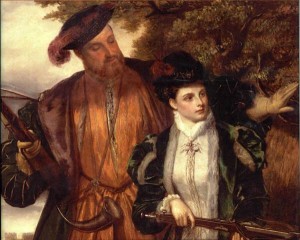 At midnight on Tuesday 12th November 1532, King Henry VIII and Anne Boleyn finally sailed from Calais bound for Dover. Henry had bid farewell to Francis I, the French King, on Tuesday 29th October but winds that were “so contrariant”, as chronicler Edward Hall describes them, prevented the royal party from setting sail straight away. Hall describes the bad weather which continued well into November:
At midnight on Tuesday 12th November 1532, King Henry VIII and Anne Boleyn finally sailed from Calais bound for Dover. Henry had bid farewell to Francis I, the French King, on Tuesday 29th October but winds that were “so contrariant”, as chronicler Edward Hall describes them, prevented the royal party from setting sail straight away. Hall describes the bad weather which continued well into November:
“in Nouember rose suche a Wynde, of the North and North Weste, that al the shippes in Caleis hauen, were in great jeoperdy, and in especial y Hoyes, at whiche season was such a spryng tide, that it brake the walles of Holland and Zelande, and drouned diuerse tounes in Flauders, in somuche that the water rose three foote aboue the wharfe, where the Key stode in Andwarpe: this storme continued till the fourth daie of Nouember, but for all that the wynd chaunged not. The eight daie rose suche a Wynde tempest and Thonder, that no man could conueniently stirre in the streates of Caleis: muche lamentacion was made for theim that had taken shippe into Englande, for no man knewe what was become of theim.”
The weather improved on Sunday 10th November, so Henry and Anne prepared to depart, having the King’s bed and luggage loaded, “but sodainly rose suche a mist, that no Master could guide a ship” and the royal couple had to wait until it cleared. They arrived at Dover at 5am on the morning of Thursday 14th November, St Erkenwald’s Day, and Hall records that the couple actually got married on that day:
“The kyng after his returne, maried priuily the lady Anne Bulleyn, on sainct Erkenwaldes daie, whiche mariage was kept so secrete, that very fewe knewe it, til she was greate with child, at Easter after.”
We don’t know whether this is true, but the couple did start co-habiting at this point, which obviously risked Anne getting pregnant.
Also on this day in history…
- 1537 – Jane Seymour’s body was taken by chariot from Hampton Court Palace to Windsor Castle. The chariot was followed by a procession led by the Duke of Suffolk and the Marquis of Dorset. Jane’s stepdaughter, the Lady Mary, acted as chief mourner in the procession and the service, which was held at St George’s Chapel on arrival at Windsor. A solemn watch was kept that night, and then Jane was buried on the morning of the 13th November.
- 1554 – The opening of Mary I’s third Parliament. At this Parliament, a bill was passed allowing the exiled Cardinal Reginald Pole to return to England as papal legate.
- 1555 – Death of Stephen Gardiner, Bishop of Winchester and Mary I’s Lord Chancellor. See Stephen Gardiner, Bishop of Winchester.
- 1555 – Mary I’s Parliament re-established Catholicism in England.
- 1586 – A delegation of forty MPs and twenty peers presented Elizabeth I with a petition demanding that “a just sentence might be followed by as just an execution” in the case of Mary, Queen of Scots.
Notes and Sources
- Hall’s Chronicle, Edward Hall, p794